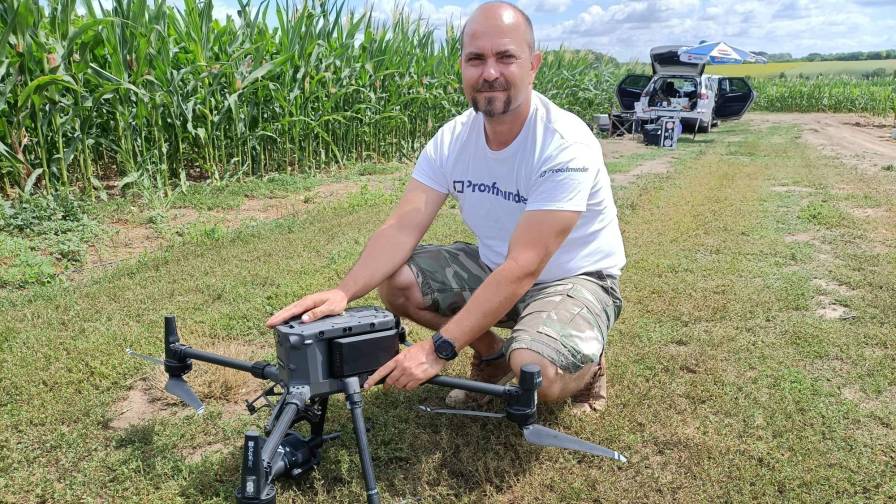Drain Gain: A Smarter Way To Install Drain Tile
Precision technology is most often discussed in terms of how difficult, inaccurate and messy tasks are made simpler, more accurate and cleaner through the use of cutting-edge equipment and software. Installing drain tile qualifies as one of the messiest and most difficult tasks a farmer can undertake, and historically technology has only been of some help.
The advent of flexible tile certainly was a significant improvement, but the biggest challenge with tile is installation — ensuring that it’s graded properly in the soil so that water can effectively drain. And until recently, laser grade control as a measure of topography was the only way to ensure the tile was properly placed for proper drainage. Laser systems work well over areas featuring small grade changes over a short range, but they become less effective on longer runs and over uneven grades.
The latest tile installation systems are employing RTK guidance — capable of effectively providing sub-inch positional accuracy both left to right and up and down — combined with a specialized plow to provide the accuracy and efficiency necessary to do the job right. And it is a system that many farmers would be capable of running themselves.
Interest in the systems has increased substantially all throughout the Midwest, generated by rainy springs of the past few years, says Mike Strahm of IntelliSlope, an RTK-based drain tile installation system based in Indiana. One of his customers is Clay Mitchell, the Buckingham, IA, farmer and technology super-user that has been featured annually in PrecisionAg Special Reports since 2003.
MORE BY PAUL SCHRIMPF
‘Future of Food’ Panel Will Deliver Compelling Close to 2022 VISION Conference in January
CoBank Report Asserts Precision Services are Essential to Future of U.S. Ag Retail
Mitchell started really emphasizing land improvement last year, when he made a concerted effort to improve field areas with low levels of topsoil. He literally scooped up and moved rich soil from the outer edges of erosion barriers and placed the soil in areas with inadequate top soil. However, it became apparent through looking at yield maps that, after three consecutive wet years, the toll that excessive moisture was taking on yields required more immediate attention.
“A lot of things you do with herbicides and variable rate patterns can be hard to recognize on maps,” he says. “Within five seconds of looking at a yield map, you see wet spots, the effects and the severity of it. Historically you might lose 100 bushels per acre on these parts of the field, and you know exactly what the problem is.
“When you try to value the land,” he continues, “drainage is the number one limitation of yield, and it’s the low hanging fruit for land improvement by a really big margin.”
Out With The Old
If installing tile on his fields were as easy as putting in new tile, Mitchell might well have finished the work this past summer. But the long- and well-serviced farmland features tile of all kinds that has been installed over the years.
“Some people get impressive return numbers with how much tile they put in, but my numbers are not so impressive because we have so much old tile to fix,” says Mitchell. “We’re in an area where tile was hand dug dating back more than 100 years. We have clay tile, as well as concrete and even some wooden tile, which is extremely rare. Concrete will slowly erode away, and the wooden tile we’ve found is almost to the point of completely rotting out.
Mitchell used the old-school tools to dig out the old tile — a backhoe attached to a tractor, and a small excavator. For putting in the new tile, he invested in a tile plow and a quad track tractor to pull it, along with the IntelliSlope in-cab hardware and software to operate the plow. RTK GPS is also required for the system, which Mitchell already has access to on his farm.
“We end up spending most of our time fixing the old tile and finding places where we need to put in a string to connect old pieces of tie where there was not one.” Unfortunately, for this aspect of tiling it means a lot of guesswork and digging. Yield maps and historic wet spots are indicators, but it still takes a lot of muscle to locate and fix issues.
“We really have no idea where tile is — we dig with the backhoe where it looks like there is a problem until we find it,” Mitchell admits.
In With The New
Installing new tile with the IntelliSlope system provides a number of advantages over traditional lasers, says Mitchell. One of the keys is the incorporation of RTK GPS, which provides full, automatic control of the tile during installation no matter how much the topography changes.
“Lasers can give you a grade, but they do not account for changes in grade,” says Mitchell. “So you can have one grade set with the laser, but you cannot know the range of grades you are going through. Conversely, RTK knows exactly where you are in the field both horizontally and vertically, and you know you have a continuous slope.”
The IntelliSlope system in the cab has the ability to record topography information about land that it passes over. The user sets the controller up with the desired grade specification. Then, to set up the tile installation path, the IntelliSlope system is driven over the path where tile is going to be installed. This information is recorded and provides the system with a guide as to how deep to place the tile throughout the recorded section of land to achieve a desired grade. The tile installing rig is driven over the exact same line and tile is installed automatically by the tile plow at the correct depth.
A benefit of this first drive through is that the system will tell you if the topography of the area will be able to accommodate the grade desired. “As you drive over the path it records the elevation changes and tells you if you will be within your specifications,” says Mitchell. “If you are within spec, it uses that path to guide the tile plow at the depth that you need to be. It knows what’s coming up and anticipates the target all the way up the string. The other nice thing about it is that there is no programming or analysis — it is totally automatic.”
Another useful benefit is the IntelliSlope’s ability to record the location of drain tile to add to the electronic field record. “We make RTK maps everyplace we find tile or place tile,” says Mitchell. “We will drive over the tile, make a map of where it is and load into the farm record keeping software.”
The cost for the IntelliSlope system with the plow and controllers is between $25,000 and $30,000, but the assurance of accuracy is worth the investment, says Mitchell. “A key point I would make about this work versus other field operations is permanence — once you lay tile correctly, it will work for decades. So, if you make even a slight mistake in grade control, you could invest $50,000 in a tile installation that does not work.” Investing in a system that works is worth every penny.










